The Indians:vassals of the new owners of the Andean world "It was not gold or silver that went to Europe from Peru, but the blood and sweat of Indians who are the ones who work in this country," said the memory of a viceroy. In his letter to the king, Guamán Poma de Ayala says:“Your Majesty alone is responsible for looking after them (the Andean men) as their king and natural lord, and grieving for their miseries and calamities, and ill treatment. and worse payments that they continually receive in general from all kinds of people, treating them worse than slaves from Guinea, who even treat these better because it costs them the price they pay for it.” "Tyrians and Trojans", then, recognized in their time the savage exploitation of the Indians.
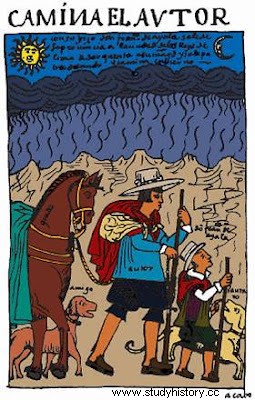 Felipe Guamán Poma de Ayala, his son Francisco, his dogs, one of which was
Felipe Guamán Poma de Ayala, his son Francisco, his dogs, one of which was called “Amigo”, and his horse. Poma de Ayala identifies himself as the "author". The “Indians always moaned in slavery more complete” “Regardless of the thousand provisions that, with truly Christian humanity and interest so worthy of recognition, dictated the monarchs, the fact is that the unfortunate Indians always groaned in the most complete slavery [...] The municipalities distributed the shifts, wages were fixed, of course, ridiculous, for individuals, and even to compulsorily provide the neighbors with yerba mate, water, firewood and other urgent daily necessities [...] Immensity of those unfortunates, in turn also obligatory in all the provinces of the Viceroyalty, who were taken from their homes and their land, leaving their relatives in the most absolute abandonment, to be occupied in the communal service of the populations or in the working and exploitation of the mines [...]” ( G. Leguía y Martínez).
The sub-castes of the Indians and their miserable conditions The Indians, during the colony, were distributed in the following groups:1. Indians of the reductions. Belonging properly to the Republic of Indians. They were obliged to pay the corresponding taxes and to buy the merchandise of the corregidores. They were also required to pay the "twenty" to the Church, which was equivalent to five percent of their agricultural production. 2. Yanacona Indians. They were the serfs in the extensive lands of the Spanish. They had been handed over to the conquerors, and their descendants, during the land distributions. This system was implemented by Francisco Pizarro and followed by the first rulers of the Colony. 3. Mitayo Indians. They were the Indians recruited to work in the mines. There were also mitayos to work on the repair or construction of roads and bridges, as well as the maintenance of dairy farms. There were those who flocked to the cities to participate in the construction of public works. Another type of mitayos were those that were organized for forced labor in the rich lands of Spaniards and Creoles. 4. Indian laborers. They were the "free" workers who did temporary services in some specialty. In that condition were, for example, stonemasons, masons, carpenters, locksmiths, etc.
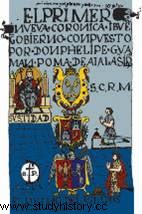 Felipe Guamán Poma book cover Felipe Guamán Poma de Ayala, an Indian nobleman Guamán Poma de Ayala possibly lived between 1532 and 1614. His place of origin is not exactly known either. He was probably from Ayacucho. He was curaca, "owner of land, collaborator of Spanish officials and interpreter between Indians and Spaniards." Guamán Poma de Ayala was, therefore, an Indian of the Tahuantinsuyan nobility; a curaca or cacique who had been stripped of his rights during the colony and who undertook the great task of "making himself respected." It is one of those typical cases of peaceful claim that the vast majority of Indians opted for before the Spanish authorities, hoping to be heard even by the kings of Spain.
Felipe Guamán Poma book cover Felipe Guamán Poma de Ayala, an Indian nobleman Guamán Poma de Ayala possibly lived between 1532 and 1614. His place of origin is not exactly known either. He was probably from Ayacucho. He was curaca, "owner of land, collaborator of Spanish officials and interpreter between Indians and Spaniards." Guamán Poma de Ayala was, therefore, an Indian of the Tahuantinsuyan nobility; a curaca or cacique who had been stripped of his rights during the colony and who undertook the great task of "making himself respected." It is one of those typical cases of peaceful claim that the vast majority of Indians opted for before the Spanish authorities, hoping to be heard even by the kings of Spain.It has gone down in history for its chronic He is known more for his work than for his biography. “Nueva coronica y Buen Gobierno” (commonly known as “New Chronicle and Good Government”) was written by Guamán Poma de Ayala between 1594 and 1614. It is written in Spanish, with various Quechua interjections and occasional Aymara phrases. For this reason, only since 1973 has the work of Guamán Poma been known in its true dimension. He is the most important indigenous chronicler in the history of Peru.
Guamán Poma, the foundation of his chronicle “The author Don Felipe Guamán Poma de Ayala, I say that the Christian reader will be amazed and scared to read this book and chronicle and chapters and they will say who taught it to me, how can he know so much. Well, I say that it cost me thirty years of work if I'm not mistaken, but for good reason twenty years of work and poverty. Leaving my houses and children and farms, and working among the poor and serving God and His Majesty, learning languages and reading and writing, serving doctors and those who do not know and those who know... And I have raised in the palace, in the house of good government and in the audience and I have served the viceroys, judges, court presidents and mayors and the most illustrious in Christ your honor bishops and the illustrious commissioners. And I have treated the parents, corregidores, comenderos, visited, serving as a tongue and conversing, asking the poor Spaniards and Indians and poor blacks. I have been visitor of the holy church and general visitor of tributary Indians and land composition. And as a poor person I deal with them and that is how they reveal to me their poverties, and the fathers of their arrogance, which if I were to write what has happened to me in the towns so much work of the arrogance of the fathers, corregidores, comendero, of chief chiefs the that persecutes the poor of Jesus Christ, there are times to cry, there are times to laugh and have pity”.
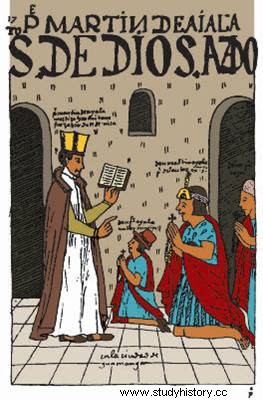 Felipe Guamán Poma de Ayala (“main author”), his father Martín de
Felipe Guamán Poma de Ayala (“main author”), his father Martín de Ayala and his wife or his coya before the bishop of Huamanga. He was a brave plea This grandson of Incas, after traveling for 30 years to various parts of the Viceroyalty of Peru, already old, with 80 years on his back, in 1614, returned to Lucanas (Ayacucho) and found that he had been dispossessed of his house and his lands. He complained to the provincial authorities; but he only managed to get the corregidor, in complicity with the parish priest, to expel him from his republic. It was the drop of water that overflowed the glass of his indignation at the mistreatment suffered by the Indians and, accepting the recommendation of a Spanish official from Potosí, he went to the court of Castile (Spain) as a complaint, sending his famous "New chronicle and good government”, of almost 800 pages and 400 illustrations. This file, in his time, was useless. His chronicle has an essential feature. A series of cartoon-type drawings but with characters captured in all their expressive dimension. These drawings explain each of the topics in a very colorful and imaginative way. It was a plea before the King of Spain for the situation experienced by the Indians in Tahuantinsuyu and the miserable life they led in the colony. It says:“Your Majesty alone is responsible for looking after them (the Andean men) as their king and natural lord who is theirs, and grieving for their miseries and calamities, and bad treatment and worse pay that they continually receive in general from all kind of people, treating them but slaves from Guinea, who even treat them better because they cost them the price they pay for them....”
“A world turned upside down” Guamán Poma de Ayala points out that the world where he lives, the Colonia, is a “world turned upside down” and that with abuses and injustices it represents chaos, very different from the old Andean world. "He finds -says Nathan Wachtel- that traditional indigenous values have been broken and that Christianity and the laws of the Crown brought by the conquerors to replace those values, are not practiced.... Poma wants to transform the society where he lives, restore it in a fair order; in short, to abolish colonial domination:this utopia leads to rebellion.”
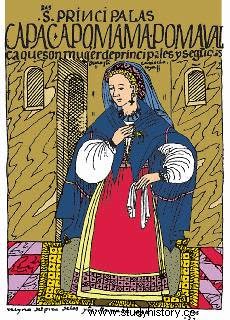 Coya “Cápac Apo Mama Poma Valca”, a main Indian woman of the
Coya “Cápac Apo Mama Poma Valca”, a main Indian woman of thelineage of Guamán Poma de Ayala, the author of this graphic chronicle. she did not like the Incas But the vision of the Incas is negative, since he presents them as cruel and illegitimate. She denounces the incest that they constantly committed, starting with Manco Cápac, who married his sister.
A situation where “...there is no remedy” In the second part, he begins with the description of towns, their festivals and customs. He goes on to denounce the "abuses of the Spaniards, the laziness and idolatry of the Indians, the greed of the caciques and the lust of the priests." He states that “there is no remedy” for this situation; although he does not stop praising the king and some colonial authorities.
Guaman Poma intended a good government of lineage chiefs “Guamán Poma was convinced racist and aristocratic and believed that the government should return to the hands of the caciques of lineage, since the problems had arisen from the confusion of the castes, from the proliferation of mestizos and mulattoes, from the destruction of the ayllus and of the usurpation of cacicazgos by common Indians. For him, it was the caciques, much more than the Incas, who embodied the legitimate authority in Peru. To carry out the changes, he came to offer himself as ruler-supervisor of Peru” (Peruvian Literature, issue 2. In:“Expreso”). “I also as a human, king of birds, fly more and am worth more”, this cult curaca used to say when confronting the Spanish authorities of the Viceroyalty, claiming against the mistreatment of the Indians under his jurisdiction. Although he did not achieve his goal, he was able to send his complaint to Spain, something that was totally alien to the miserable life of almost all the inhabitants of the Indian republics.
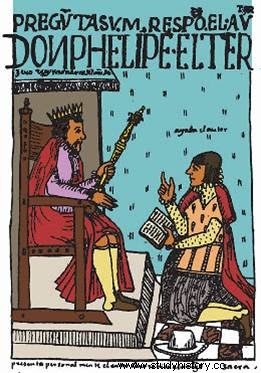 The “author” asks his majesty Philip II. Guamán Poma de
The “author” asks his majesty Philip II. Guamán Poma deAyala imagined this scene when facing the King of Spain. Guaman Poma: Fictitious name or real? However, a document signed by Anelio Oliva has recently been found in an Italian archive. “There it is argued that Blas Valera and Anelio Oliva himself conspired and used the name of Guamán Poma to write the Chronicle and present their ideas. This is because Valera was prohibited by his order (he was a Jesuit) from writing or formulating opinions. The veracity and value of this testimony has not yet been fully evaluated. Even if this thesis were to be verified, the value of the work, although it would change, would not decrease.
Chroniclers of the same lineage Other Indian chroniclers were:1. Titu Cusi Yupanqui. Third Inca of Vilcabamba; son of Manco Inca. In 1570 he dictated to a Spanish priest the episodes of that indigenous resistance.2. Juan Santa Cruz Pachacuti Yampi Salcamaygua. Author of the “List of antiquities of this kingdom of Pirú”. It was a title put by someone else's hand. It was written in the early years of the eighteenth century. It deals with Andean history from the creation of the world and the first man to the conquest of Tahuantinsuyu by Pizarro. He interposes a series of traditions in that history, which make it a valuable document of the cultural life of the ancient Andean world.
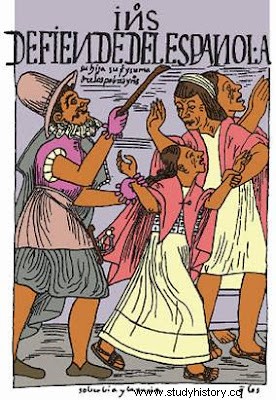 Mother and father defend her daughter from mistreatment by a Spaniard
Mother and father defend her daughter from mistreatment by a Spaniard ( Guamán Poma de Ayala). A valuable document historical Since the "New Chronicle and Good Government" was discovered in 1908, by Richard Pietschmann, in the Royal Library of Copenhagen (Denmark), and published in France in 1936, it has served to unravel many mysteries of colonial government; among them, those that occurred in the republics of Indians and in the townships.
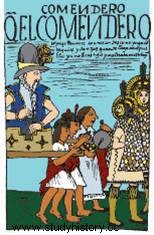
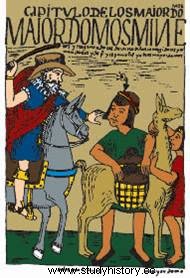 With whip in hand, a corregidor sheriff forces
With whip in hand, a corregidor sheriff forcessome Indian muleteers to carry came to Huancavelica to
negotiate it (Guaman Poma de Ayala)
JULIO VILLANUEVA SOTOMAYOR BIOGRAPHY "Felipe Guamán Poma de Ayala"
